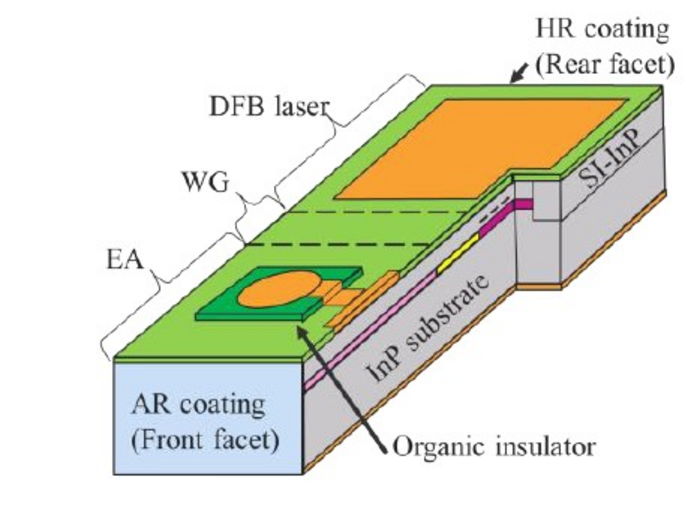Researchers at Japan's Langmeitong Corporation have developed a new distributed feedback (DFB) laser and demonstrated that it can transmit data at 200Gb/s (gigabytes per second) over a record-breaking distance of 10 kilometers. This research helps advance network technology, allowing Internet data centers to process data at unprecedented levels. Langmeitong will present the new research at the Optical Fiber Communications Conference (OFC) in San Diego, California, from March 5 to 9.
Researchers say this research will help develop next-generation data centers for 800G and 1.6T Ethernet. In particular, new technology shows that electroabsorption modulators with integrated distributed feedback (EA-DFB) lasers can even use conventional PAM4 (pulse amplitude modulation) technology for transmission up to 10 kilometers.

Schematic diagram of LE type EA-DFB laser. Image source: Japan Langmeitong Company
As communication traffic continues to increase, there is increasing focus on implementing next-generation Ethernet technologies, such as 800G and 1.6T Ethernet, to help data centers meet growing demands. Although the same PAM4 technology used for 2km transmission in today's 400G Ethernet is being considered for 800G, new technology is needed to enable long-distance data transmission for interconnections between data center areas.
In this new work, the researchers developed EA-DFB lasers to achieve longer transmission distances. They first used the new laser to demonstrate 5-km transmission of 225Gb/s PAM4 using the coarse wavelength division multiplexing (CWDM) band at 50°C. They also used lasers to complete 10-kilometer transmission of 225Gb/s PAM4 at the 1293.5nm band. The dispersion of this wavelength is smaller than the range of wavelengths allocated to CWDM, which is commonly used to send multiple optical signals simultaneously through optical fibers. Dispersion will cause optical signal degradation, which is not conducive to longer-distance transmission.
In experiments, the performance of the new laser was stable. Researchers say that EA-DFB is a promising light source for the upcoming 800G Ethernet technology applications.
Imagine that you have 200Gb of video resources stored in your mobile hard drive, and you want to transmit them all to a friend 10 kilometers away from you through the network. Using this new laser technology, the transmission is completed in just 1 second. In the blink of an eye, your friend has received everything. If network transmission becomes so fast in the future, will human society undergo earth-shaking changes? Of course, when paying attention to the powerful performance of this new laser, we should not ignore the key core technology behind it - the research and development of new generation optoelectronic components and related new materials.
Previous article:5G radio networks: the heart of the factory of the future
Next article:Qualcomm launches world’s first 5G NR-Light modem and RF system, enabling a new round of 5G terminal expansion
Recommended ReadingLatest update time:2024-11-16 09:17
- Wi-Fi 8 specification is on the way: 2.4/5/6GHz triple-band operation
- Three steps to govern hybrid multicloud environments
- Microchip Accelerates Real-Time Edge AI Deployment with NVIDIA Holoscan Platform
- Keysight Technologies FieldFox handheld analyzer with VDI spread spectrum module to achieve millimeter wave analysis function
- Qualcomm launches its first RISC-V architecture programmable connectivity module QCC74xM, supporting Wi-Fi 6 and other protocols
- Microchip Launches Broadest Portfolio of IGBT 7 Power Devices Designed for Sustainable Development, E-Mobility and Data Center Applications
- Infineon Technologies Launches New High-Performance Microcontroller AURIX™ TC4Dx
- Rambus Announces Industry’s First HBM4 Controller IP to Accelerate Next-Generation AI Workloads
- NXP FRDM platform promotes wireless connectivity
- Innolux's intelligent steer-by-wire solution makes cars smarter and safer
- 8051 MCU - Parity Check
- How to efficiently balance the sensitivity of tactile sensing interfaces
- What should I do if the servo motor shakes? What causes the servo motor to shake quickly?
- 【Brushless Motor】Analysis of three-phase BLDC motor and sharing of two popular development boards
- Midea Industrial Technology's subsidiaries Clou Electronics and Hekang New Energy jointly appeared at the Munich Battery Energy Storage Exhibition and Solar Energy Exhibition
- Guoxin Sichen | Application of ferroelectric memory PB85RS2MC in power battery management, with a capacity of 2M
- Analysis of common faults of frequency converter
- In a head-on competition with Qualcomm, what kind of cockpit products has Intel come up with?
- Dalian Rongke's all-vanadium liquid flow battery energy storage equipment industrialization project has entered the sprint stage before production
- Allegro MicroSystems Introduces Advanced Magnetic and Inductive Position Sensing Solutions at Electronica 2024
- Car key in the left hand, liveness detection radar in the right hand, UWB is imperative for cars!
- After a decade of rapid development, domestic CIS has entered the market
- Aegis Dagger Battery + Thor EM-i Super Hybrid, Geely New Energy has thrown out two "king bombs"
- A brief discussion on functional safety - fault, error, and failure
- In the smart car 2.0 cycle, these core industry chains are facing major opportunities!
- The United States and Japan are developing new batteries. CATL faces challenges? How should China's new energy battery industry respond?
- Murata launches high-precision 6-axis inertial sensor for automobiles
- Ford patents pre-charge alarm to help save costs and respond to emergencies
- New real-time microcontroller system from Texas Instruments enables smarter processing in automotive and industrial applications

 Digilent Vivado library
Digilent Vivado library Computer Control Systems (Second Edition) (Liu Jianchang)
Computer Control Systems (Second Edition) (Liu Jianchang)













 京公网安备 11010802033920号
京公网安备 11010802033920号